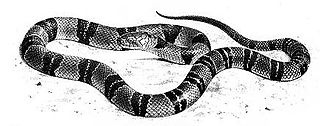
The greater yellowlegs is a large shorebird in the family Scolopacidae. It breeds in central Canada and southern Alaska and winters in southern North America, Central America, the West Indies and South America.

Ailuropoda is the only extant genus in the ursid (bear) subfamily Ailuropodinae. It contains one living and three fossil species of panda.

The red-billed pied tanager is a species of bird in the family Mitrospingidae. It is found in Bolivia, Brazil, French Guiana, Guyana, Peru and Suriname. Placed in family Thraupidae, the "true" tanagers, for over two centuries, the International Ornithological Committee reclassified this species to Mitrospingidae in 2018.

Naja is a genus of venomous elapid snakes commonly known as cobras. Members of the genus Naja are the most widespread and the most widely recognized as "true" cobras. Various species occur in regions throughout Africa, Southwest Asia, South Asia, and Southeast Asia. Several other elapid species are also called "cobras", such as the king cobra and the rinkhals, but neither are true cobras, in that they do not belong to the genus Naja, but instead each belong to monotypic genera Hemachatus and Ophiophagus.

Boulengerina is a genus or subgenus of elapid venomous snakes known commonly as water cobras, so named because of their semiaquatic nature. The genus has two recognised species, which are native to central and southern Africa.
Melaleuca is a plant genus in the family Myrtaceae containing the paperbarks.

The black-collared swallow is a species of bird in the family Hirundinidae. It is found in Argentina, Bolivia, Brazil, Colombia, French Guiana, Guyana, Paraguay, Suriname, and Venezuela. Its natural habitat is rivers.

Pygochelidon is a genus of birds in the swallow family Hirundinidae that occur in the Neotropics.

Melanoleuca is a poorly known genus of saprotrophic mushrooms traditionally classified in the family Tricholomataceae. Most are small to medium sized, white, brown, ocher or gray with a cylindrical to subcylindrical stipe and white to pale yellowish gills. The basidiospores are ellipsoid and ornamented with amyloid warts. Melanoleuca is considered a difficult group to study due to their macroscopic similarities among species and the need of a thorough microscopic analysis to separate species. DNA studies have determined that this genus is closely related to Amanita and Pluteus and that it does not belong to the family Tricholomataceae.
A. melanoleuca may refer to:
H. melanoleuca may refer to:
L. melanoleuca may refer to:

The forest cobra, also commonly called the black cobra and the black and white-lipped cobra, is a species of venomous snake in the family Elapidae. The species is native to Africa, mostly the central and western parts of the continent. It is the largest true cobra species with a record length of 3.2 metres.
Melanoleuca privernensis is a species of fungus in the Pluteaceae family. It was originally named Kinia privernensis in 2008 and a new genus Kinia was erected to contain it. Two years later, molecular analysis showed that it was closely related to Melanoleuca, and Kinia was reduced to a subgenus of Melanoleuca.

Melanoleuca melaleuca is a species of mushroom in the family Tricholomataceae, and it is the type species of its genus Melanoleuca. It is difficult to distinguish from other related species firstly because it is variable, secondly because the taxonomic criteria are often based on characteristics which have later been found to be variable, and thirdly because there is much disagreement between authorities as to exactly how the species should be defined.
Milgithea melanoleuca is a species of snout moth in the genus Milgithea. It was described by George Hampson in 1896. It is found in Colombia.
Henricus melanoleuca is a species of moth of the family Tortricidae. It is found in Mexico and Ecuador.
Black-eared wheatear has been split into the following 2 species:
The black forest cobra is a species of cobra in the genus Naja that is found in West Africa.
This page is based on this
Wikipedia article Text is available under the
CC BY-SA 4.0 license; additional terms may apply.
Images, videos and audio are available under their respective licenses.









